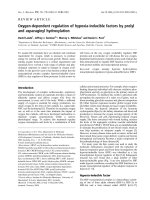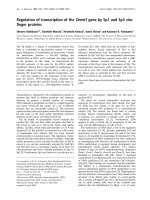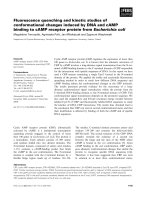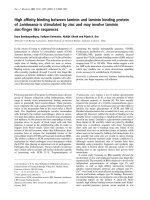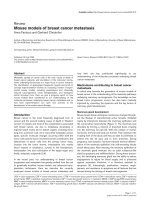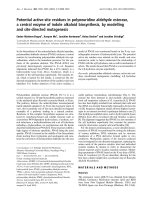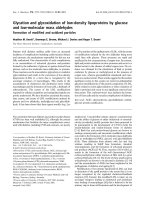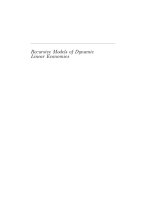recursive models of dynamic linear economies by hansen and sargent 2005 (526 pages)
Bạn đang xem bản rút gọn của tài liệu. Xem và tải ngay bản đầy đủ của tài liệu tại đây (2.01 MB, 526 trang )
Recursive Models of Dynamic
Linear Economies
Recursive Models of Dynamic
Linear Economies
Lars Hansen
University of Chicago
Thomas J. Sargent
New York University
and
Hoover Institution
c
Lars Peter Hansen and Thomas J. Sargent 21 March 2005
Contents
Acknowledgements xii
Preface xiii
Part I: Components of an economy
1. Introduction 3
1.1. Introduction. 1.2. Computer Programs. 1.3. Organization.
2. Stochastic Linear Difference Equations 9
2.1. Introduction. 2.2. Notation and Basic Assumptions. 2.3. Predic-
tion Theory. 2.4. Transforming Variables to Uncouple Dynamics. 2.5.
Examples. 2.5.1. Deterministic seasonals. 2.5.2. Indeterministic season-
als. 2.5.3. Univariate autoregressive processes. 2.5.4. Vector autoregres-
sions. 2.5.5. Polynomial time trends. 2.5.6. Martingales with drift. 2.5.7.
Covariance stationary processes. 2.5.8. Multivariate ARMA processes.
2.5.9. Prediction of a univariate first order ARMA. 2.5.10. Growth.
2.5.11. A rational expectations model. 2.6. The Spectral Density Ma-
trix. 2.7. Computer Examples. 2.7.1. Deterministic seasonal. 2.7.2.
Indeterministic seasonal, unit root. 2.7.3. Indeterministic seasonal, no
unit root. 2.7.4. First order autoregression. 2.7.5. Second order autore-
gression. 2.7.6. Growth with homoskedastic noise. 2.7.7. Growth with
heteroskedastic noise. 2.7.8. Second order vector autoregression. 2.7.9.
A rational expectations model. 2.8. Conclusion.
3. The Economic Environment 39
3.1. Information. 3.2. Taste and Technology Shocks. 3.3. Technologies.
3.4. Examples of Technologies. 3.4.1. Other technologies. 3.5. Prefer-
ences and Household Technologies. 3.6. Examples of Household Tech-
nology Preference Structures. 3.7. Constraints to Keep the Solutions
“Square Summable”. 3.8. Summary.
– v –
vi Contents
4. Optimal Resource Allocation 57
4.1. Planning problem. 4.2. Lagrange Mmultipliers. 4.3. Dynamic pro-
gramming. 4.4. Lagrange multipliers as gradients of value function. 4.5.
Planning problem as linear regulator. 4.6. Solutions for five economies.
4.6.1. Preferences. 4.6.2. Technology. 4.6.3. Information. 4.6.4. Brock-
Mirman model. 4.6.5. A growth economy fueled by habit persistence.
4.6.6. Lucas’s pure exchange economy. 4.6.7. An economy with a
durable consumption good. 4.7. Hall’s model. 4.8. Higher Adjustment
Costs. 4.9. Altered ‘growth condition’. 4.10. A Jones-Manuelli economy.
4.11. Durable consumption goods. 4.12. Summary. A. Synthesizing the
linear regulator. B. A Brock-Mirman model. 4.B.1. Uncertainty. 4.B.2.
Optimal Stationary States.
5. The Commodity Space 105
5.1. Valuation. 5.2. Price systems as linear functionals. 5.3. A one
period model under certainty. 5.4. One period under uncertainty. 5.5.
An infinite number of periods and uncertainty. 5.5.1. Conditioning in-
formation. 5.6. Lagrange multipliers. 5.7. Summary. A. Appendix.
6. A Competitive Economy 113
6.1. Introduction. 6.2. The Problems of Households and Firms. 6.2.1.
Households. 6.2.2. Firms of type I. 6.2.3. Firms of type II. 6.3. Compet-
itive Equilibrium. 6.4. Lagrangians. 6.4.1. Households. 6.4.2. Firms of
type I. 6.4.3. Firms of type II. 6.5. Equilibrium Price System. 6.6. Asset
Pricing. 6.7. Term Structure of Interest Rates. 6.8. Re-opening Mar-
kets. 6.8.1. Recursive price system. 6.8.2. Non-Gaussian asset prices.
6.9. Summary of Pricing Formulas. 6.10. Asset Pricing Example. 6.10.1.
Preferences. 6.10.2. Technology. 6.10.3. Information. 6.11. Exercises.
7. Applications 139
7.1. Introduction. 7.2. Partial Equilibrium Interpretation. 7.2.1. Par-
tial equilibrium investment under uncertainty. 7.3. Introduction. 7.4.
A Housing Model. 7.4.1. Demand. 7.4.2. House producers. 7.5. Cattle
Cycles. 7.5.1. Mapping cattle farms into our framework. 7.5.2. Pref-
erences. 7.5.3. Technology. 7.6. Models of Occupational Choice and
Pay. 7.6.1. A one-occupation model. 7.6.2. Skilled and unskilled work-
ers. 7.7. A Cash-in-Advance Model. 7.7.1. Reinterpreting the household
technology. 7.8. Taxation in a Vintage Capital Model. A. Decentralizing
the Household.
Contents vii
8. Efficient Computations 157
8.1. Introduction. 8.2. The Optimal Linear Regulator Problem. 8.3.
Transformations to eliminate discounting and cross-products. 8.4. Sta-
bility Conditions. 8.5. Invariant Subspace Methods. 8.5.1. P x as La-
grange multiplier. 8.5.2. Invariant subspace methods. 8.5.3. Distorted
Economies. 8.5.4. Transition Dynamics. 8.6. The Doubling Algorithm.
8.7. Partitioning the State Vector. 8.8. The Periodic Optimal Linear
Regulator. 8.9. A Periodic Doubling Algorithm. 8.9.1. Partitioning
the state vector. 8.10. Linear Exponential Quadratic Gaussian Control.
8.10.1. Doubling algorithm. A. Concepts of Linear Control Theory. B.
Symplectic Matrices. C. Alternative forms of Riccati equation.
viii Contents
Part II: Representations and Properties
9. Representation and Estimation 187
9.1. The Kalman Filter. 9.2. Innovations Representation. 9.3. Conver-
gence results. 9.3.1. Time-Invariant Innovations Representation. 9.4.
Serially Correlated Measurement Errors. 9.5. Combined System. 9.6.
Recursive Formulation of Likelihood Function. 9.6.1. Initialization.
9.6.2. Non-existence of a stationary distribution. 9.6.3. Serially cor-
related measurement errors. 9.7. Wold Representation. 9.8. Vector Au-
toregression for {y
t
}. 9.8.1. The factorization identity. 9.8.2. Location
of zeros of characteristic polynomial. 9.8.3. Wold and autoregressive
representations (white measurement errors). 9.8.4. Serially correlated
measurement errors. 9.9. Innovations in y
t+1
as Functions of Innova-
tions w
t+1
and η
t+1
. 9.10. Innovations in the y
t
’s and the w
t
’s in
a Permanent Income Model. 9.10.1. Preferences. 9.10.2. Technology.
9.10.3. Information. 9.11. Frequency Domain Estimation. 9.12. Ap-
proximation Theory. 9.13. Aggregation Over Time. 9.14. Simulation
Estimators. A. Initialization of the Kalman Filter.
10. Semiparametric Estimation with Limited Information 227
10.1. Introduction. 10.2. Underlying Economic Model. 10.3. Econome-
trician’s information and the implied orthogonality conditions. 10.4. An
Adjustment Cost Example. 10.5. A Slightly Simpler Estimation Prob-
lem. 10.5.1. Scalar Parameterizations of B. 10.6. Multidimensional
Parameterizations of B . 10.7. Nonparametric Estimation of B . 10.8.
Back to the Adjustment Cost Model.
11. Representation of Demand 239
11.1. Introduction. 11.2. Canonical Representations of Services. 11.3.
Dynamic Demand Functions for Consumption Goods. 11.3.1. The mul-
tiplier µ
w
0
. 11.3.2. Dynamic Demand System. 11.3.3. Foreshadow of
Gorman aggregation. 11.4. Computing Canonical Representations. 11.4.1.
Heuristics. 11.4.2. An auxiliary problem that induces a canonical rep-
resentation. 11.5. Operator Identities. 11.6. Becker-Murphy Model of
Rational Addiction. A. Fourier transforms. 11.A.1. Primer on trans-
forms. 11.A.2. Time reversal and Parseval’s formula. 11.A.3. One sided
Contents ix
sequences. 11.A.4. Useful properties. 11.A.5. One sided transforms.
11.A.6. Discounting. 11.A.7. Fourier transforms. 11.A.8. Verifying
Equivalent Valuations. 11.A.9. Equivalent representations of prefer-
ences. 11.A.10. First term: factorization identity. 11.A.11. Second term.
11.A.12. Third term.
12. Gorman Heterogeneous Households 265
12.1. Introduction. 12.2. A Digression on Gorman Aggregation. 12.3.
An Economy with Heterogeneous Consumers. 12.4. Allocations. 12.4.1.
Consumption sharing rules. 12.5. Risk Sharing Implications. 12.6. Im-
plementing the Allocation Rule with Limited Markets. 12.7. A Com-
puter Example. 12.8. Exercises. 12.8.1. Part one. 12.8.2. Part two.
12.9. Economic integration. 12.9.1. Preferences:. 12.9.2. Technology.
12.9.3. Information.
13. Permanent Income Models 287
13.1. Technology. 13.2. Two Implications. 13.3. Solution. 13.4. Deter-
ministic Steady States. 13.5. Cointegration. 13.6. Constant Marginal
Utility of Income. 13.7. Consumption Externalities. 13.8. Tax Smooth-
ing Models.
14. Non-Gorman Heterogeneity Among Households 307
14.1. Introduction. 14.2. Households’ Preferences. 14.2.1. Technol-
ogy. 14.3. A Pareto Problem. 14.4. Competitive Equilibrium. 14.4.1.
Households. 14.4.2. Firms of type I and II. 14.4.3. Definition of compet-
itive equilibrium. 14.5. Computation of Equilibrium. 14.5.1. Candidate
equilibrium prices. 14.5.2. A Negishi algorithm. 14.6. Mongrel Aggrega-
tion. 14.6.1. Static demand. 14.6.2. Frequency domain representation of
preferences. 14.7. A Programming Problem for Mongrel Aggregation.
14.7.1. Factoring S
S . 14.8. Summary of Findings. 14.9. The Mon-
grel Preference Shock Process. 14.9.1. Interpretation of ˆs
t
component.
14.10. Choice of Initial Conditions.
x Contents
Part III: Extensions
15. Equilibria with Distortions 331
15.1. Introduction. 15.2. A Representative Agent Economy with Dis-
tortions. 15.2.1. a. Consumption externalities. 15.2.2. b. Production
externalities. 15.2.3. c. Taxes. 15.3. Households. 15.4. Firms. 15.5.
Information. 15.6. Equilibrium. 15.7. Heterogeneous Households with
Distortions. 15.7.1. Households. 15.7.2. Firms of type I. 15.7.3. Firms of
type II. 15.7.4. Government. 15.7.5. Definition of equilibrium. 15.7.6.
Equilibrium computation. 15.8. Government Deficits and Debt. 15.9.
Examples. 15.9.1. A production externality. 15.9.2. Consumption tax
only. 15.9.3. Machinery investment subsidy. 15.9.4. ‘Personal’ habit
persistence. 15.9.5. ‘Social’ habit persistence. 15.10. Conclusions. A.
Invariant subspace equations for first specification. 15.A.1. Household’s
Lagrangian. 15.A.2. Firm’s first order conditions. 15.A.3. Representa-
tiveness conditions. B. Invariant subspace equations for heterogeneous
agent model.
16. Recursive Risk Sensitive Control 367
16.1. Introduction. 16.2. A Control Problem. 16.3. Pessimistic Inter-
pretation. 16.4. Recursive Preferences. 16.4.1. Endowment economy.
16.5. Asset Pricing. 16.6. Characterizing the Pricing Expectations Op-
erator. 16.7. Production Economies. 16.8. Risk-Sensitive Investment
under Uncertainty. 16.9. Equilibrium Prices in the Adjustment Cost
Economies.
17. Periodic Models of Seasonality 385
17.1. Introduction. 17.2. A Periodic Economy. 17.3. Asset Pricing.
17.4. Prediction Theory. 17.5. The Term Structure of Interest Rates.
17.6. Conditional Covariograms. 17.7. The Stacked and Skip-Sampled
System. 17.8. Covariances of the Stacked, Skip Sampled Process. 17.9.
The Tiao-Grupe Formula. 17.9.1. A state space realization of the Tiao-
Grupe formulation. 17.10. Some Calculations with a Periodic Hall
Model. 17.11. Periodic Innovations Representations for the Periodic
Model. A. A Model of Disguised Periodicity. 17.13. A1. Two Illustra-
tions of Disguised Periodicity. 17.14. A2. Mathematical Formulation of
Disguised Periodicity.
Contents xi
Part IV: Economies as Objects
18. Introduction to Objects 425
18.1. Matlab Objects. 18.1.1. Definitions. 18.1.2. Matlab Specifics.
18.1.3. How to Define a Matlab Class. 18.2. Summary.
19. Economies as Matlab Objects 431
19.1. Introduction. 19.2. Parent Classes: Information. 19.2.1. Struc-
ture. 19.2.2. Functions. 19.3. Parent Classes: Technology. 19.3.1. Struc-
ture. 19.3.2. Functions. 19.4. Parent Classes: Preferences. 19.4.1.
Structure. 19.4.2. Functions. 19.5. Child Class: Economy. 19.5.1. Struc-
ture. 19.5.2. Fields containing the history of the economy. 19.5.3.
Functions. 19.5.4. Constructing the object and changing parameters.
19.5.5. Analyzing the economy. 19.6. Working with economies. 19.6.1.
The built-in economies. 19.6.2. Mixing and matching built-in parent
objects. 19.6.3. Building your own economy. 19.7. Tutorial.
20. MATLAB Programs 441
20.1. Matlab programs.
21. References 495
22. Index 509
23. Author Index 513
24. Matlab Index 515
Acknowledgements
– xii –
Preface
– xiii –
Part I
Components of an economy
Chapter 1
Introduction
1.1. Introduction
This book views many apparently disparate dynamic economic models as ex-
amples of a single class of models that can be adapted and specialized to study
diverse economic phenomena. The class of models was created by using recent
advances in (i) the theory of recursive dynamic competitive economies;
1
(ii)
methods for estimating and interpreting vector autoregression;
2
(iii) linear op-
timal control theory;
3
and (iv) computer languages for rapidly manipulating
linear optimal control systems.
4
We combine these elements to build a class of
models for which the competitive equilibria are vector autoregressions that can
be swiftly computed, represented, and simulated using the methods of linear
optimal control theory. We use the computer language MATLAB to implement
the computations. This language has a powerful vocabulary and a convenient
structure that liberate time and energy from programming, and thereby spur
creative application of linear control theory.
Our goal has been to create a class of models that merge recursive economic
theory and with dynamic econometrics.
Systems of autoregressions and of mixed autogregressive, moving average
processes are a dominant setting for dynamic econometrics. We constructed our
economic models by adopting a version of recursive competitive theory in which
an outcome of theorizing is a vector autoregression.
We formulated this class of models because practical difficulties of comput-
ing and estimating recursive equilibrium models still limit their use as a tool
for thinking about applied problems in economic dynamics. Recursive competi-
tive equilibria were themselves developed as a special case of the Arrow-Debreu
competitive equilibrium, both to restrict the range of outcomes possible in the
1
This work is summarized by Harris (1987) and Stokey, Lucas, and Prescott (1989).
2
See Sims (1980), Hansen and Sargent (1980, 1981, 1990).
3
For example, see Kwakernaak and Sivan (1972), and Anderson and Moore (1979).
4
See the MATLAB manual.
– 3 –
4 Introduction
Arrow-Debreu setting and to create a framework for studying applied problems
in dynamic economies of long duration. Relative to the general Arrow-Debreu
setting, the great advantage of the recursive competitive equilibrium formulation
is that equilibria can be computed by solving a discounted dynamic program-
ming problem. Further, under particular additional conditions, an equilibrium
can be represented as a Markov process in the state variables. When that
Markov process has an invariant distribution to which the process converges,
there exists a vector autoregressive representation. Thus, the theory of recur-
sive competitive equilibria holds out the promise of making closer contact with
econometric theory than did previous formulations of equilibrium theory.
Two computational difficulties have left much of this promise unrealized.
The first is Bellman’s “curse of dimensionality” which usually makes dynamic
programming a costly procedure for systems with even small numbers of state
variables. The second problem is that after a dynamic program has been solved
and the equilibrium Markov process computed, the vector autoregression implied
by the theory has to be computed by applying classic projection formulas to a
large number of second moments of the stationary distribution associated with
that Markov process. Typically, each of these computational problems can be
solved only approximately. Good research along a number of lines is now being
directed at evaluating alternative ways of making these approximations.
5
The need to make these approximations originates in the fact that for gen-
eral functional forms for objective functions and constraints, even one iteration
on the functional equation of Richard Bellman cannot be performed analytically.
It so happens that the functional forms economists would most like to use have
been of this general class for which Bellman’s equation cannot be iterated upon
analytically.
Linear control theory studies the most important special class of prob-
lems for which iterations on Bellman’s equation can be performed analytically:
problems with a quadratic objective function and a linear transition function.
Application of dynamic programming leads to a system of well understood and
rapidly solvable equations known as the matrix Riccati equation.
The philosophy of this book is to swallow hard and to accept up front
as primitive descriptions of tastes, technology, and information specifications
that satisfy the assumptions of linear optimal control theory. This approach
5
See Marcet (1989) and Judd (1990). Also see Coleman (1990) and Tauchen (1990).
Organization 5
purchases the ability rapidly to compute equilibria together with a form of equi-
librium that is automatically in the form of a vector autoregression. A cost
of the approach is that it does not accommodate many specifications that we
would like to be able to analyze.
The purpose of this book is to display the versatility and tractability of
our class of models. Versions of a wide range of models from modern capital
theory and asset pricing theory can be represented within our framework. The
equilibria of these models can be computed so easily that we hope that the
reader will soon be thinking of improvements to our specifications. We provide
formulas and software for the reader to experiment.
1.2. Computer Programs
In writing this book, we put ourselves under a restriction that we should supply
the reader with a computer program that implements every equilibrium concept
and mathematical representation that we describe. The programs are written in
MATLAB, and are described throughout the book. When a MATLAB program
is referred to in the text, we place it in typewriter font. Similarly, all computer
code is placed in typewriter font.
6
You will get much more out of this book
if you use and modify our programs as you read.
1.3. Organization
This book is organized as follows. Chapter 10 describes the first order lin-
ear vector stochastic difference equation, and shows how special cases of it are
formed by a variety of models of time series processes that have been studied by
economists. This difference equation will be used to represent the information
flowing to economic agents within our models. It will also be used to represent
the equilibrium of the model.
Chapter 3 defines an economic environment in terms of the preferences of
a representative agent, the technology for producing goods, stochastic processes
6
To run our programs, you will need MATLAB’s Control Toolkit in addition to the basic
MATLAB software.
6 Introduction
disturbing preferences and the technology, and the information structure of the
economy. The stochastic processes fit into the model introduced in chapter 10,
while the preferences, technology, and information structure are specified with
an eye toward making the competitive equilibrium one that can be computed
by the application of linear control theory.
Chapter 4 describes a social planning problem associated with the equilib-
rium of the model. The problem is formulated in two ways, first as a variational
problem using stochastic Lagrange multipliers, and then as a dynamic program-
ming problem. We describe how to compute the solution of the dynamic pro-
gramming problem using formulas from linear control theory. The solution of
the social planning problem is a first order vector stochastic difference equation
of the form studied in chapter 10. We also show how to use the value function
for the social planning problem to compute the Lagrange multipliers associated
with the planning problem. These multipliers are later used in chapter 6 to
compute the equilibrium price system.
Chapter 5 describes the price system and the commodity space that sup-
port a competitive equilibrium. We use a formulation that lets the values that
appear in agents’ budget constraints and objective functions be represented as
conditional expectations of geometric sums of streams of future “prices” times
quantities. Chapter 5 relates these prices to Arrow-Debreu state contingent
prices.
Chapter 6 describes a decentralized version of our economy, and defines and
computes a competitive equilibrium. Competitive equilibrium quantities solve a
social planning problem. The price system can be deduced from the stochastic
Lagrange multipliers associated with the social planning problem.
Chapter 7 describes versions of several dynamic models from the literature
that fit easily within our class of models.
Chapter 9 describes the links between our theoretical equilibrium and au-
toregressive representations of time series of observables. We show how to obtain
an autoregressive representation for a list of observable variables that are linear
functions of the state variables of the model. The autoregressive representation
is naturally affiliated with a recursive representation of the likelihood function
for the observable variables. In describing how to deduce the autoregressive
representation from the parameters determining the equilibrium of the model,
and possibly also from parameters of measurement error processes, we are com-
pleting a key step needed to permit econometric estimation of the model’s free
Organization 7
parameters. Chapter 9 also treats two other topics intimately related to econo-
metric implementation of the models; aggregation over time, and the theory of
approximation of one model by another.
Chapter 8 describes fast methods to compute equilibria. We describe how
doubling algorithms can speed the computation of expectations of geometric
sums of quadratic forms, and help to solve dynamic programming problems.
Chapter 11 describes alternative ways to represent demand. It identifies
an equivalence class of preference specifications that imply the same demand
functions, and characterizes a special subset of them as canonical household
preferences. Canonical representations of preferences are useful for describing
economies with heterogeneity among household’s preferences.
Chapter 12 describes a version of our economy with the type of heterogene-
ity among households allowed when preferences aggregate in a sense introduced
by Terrance Gorman . In this setting, affine Engle curves of common slope pre-
vail and give rise to a representative consumer. This representative consumer is
‘easy to find,’ and from the point of view of equilibrium computation of prices
and aggregate quantities, adequately stands in for the household of chapters 3–6.
The allocations to individual consumers require additional computations, which
this chapter describes.
Chapter 13 uses our model of preferences to represent multiple goods ver-
sions of permanent income models along the lines of Robert Hall’s (1978). We
retain Hall’s specification of the ‘storage’ technology for accumulating physical
assets, and also the restriction on the discount factor, depreciation rate, and
gross return on capital that delivered to Hall a martingale for the marginal
utility of consumption. Adopting Hall’s specification of the storage technology
imparts a martingale characterization to the model, but it is hidden away in an
‘index’ whose increments drive the behavior of consumption demands for various
goods, which themselves are not martingales. This model forms a convenient
laboratory for thinking about the sources in economic theory of ‘unit roots’ and
‘co-integrating vectors.’
Chapter 14 describes a setting in which there is more heterogeneity among
households’ preferences, causing the conditions for Gorman aggregation to fail.
Households’ Engle curves are still affine, but dispersion of their slopes arrests
Gorman aggregation. There is another sense, originating with Negishi, in which
there is a representative household whose preferences represent a complicated
kind of average over the preferences of different types of households. We show
8 Introduction
how to compute and interpret this preference ordering over economy-wide aggre-
gates. This average preference ordering cannot be computed before one knows
the distribution of wealth evaluated at equilibrium prices.
Chapter 15 describes economies with production and consumption exter-
nalities and also distortions due to a government’s imposing distorting flat rate
taxes. Equilibria of these economies has to be computed by a direct attack on
Euler equations and budget constraints, rather than via dynamic programming
for an artificial social planning problem.
Chapter 16 describes a recursive version of Jacobson’s and Whittle’s ‘risk
sensitive’ preferences. This preference specification has the features that, al-
though it violates certainty equivalence – so that the conditional covariance of
forecast error distributions impinge on equilibrium decision rules – it does so in
a way that preserves linear equilibrium laws of motion, and retains calculation
of equilibria and asset prices via simple modifications of our standard formulas.
These preferences are a version of those studied by Epstein and Zin ( ) and
Weil ( ).
Chapter 17 describes how to adapt our setup to include features of the
periodic models of seasonality that have been studied by Osborne (1988), Todd
(1990), and Ghysels (1993).
Chapter 20 is a manual of the MATLAB programs that we have prepared
to implement the calculations described in this book. The design is consistent
with other MATLAB manuals.
The notion of duality and the ‘factorization identity’ from recursive lin-
ear optimal control theory are used repeatedly in Chapter 9 (on representing
equilibria econometrically), and chapters 11, 12, and 14 (on representing and
aggregating preferences). ‘Duality’ is the observation that recursive filtering
problems (Kalman filtering) have the same mathematical structure as recursive
formulations of linear optimal control problems (leading to Riccati equations via
dynamic programming). That duality applies so often in our settings in effect
‘halves’ the mathematical apparatus that we require.
Chapter 2
Stochastic Linear Difference Equations
2.1. Introduction
This chapter introduces the first-order vector linear stochastic difference equa-
tion, which we use in two important ways. We use it first to represent the
information flowing to economic agents, then again to represent equilibria of
our models. The first-order linear stochastic difference equation is associated
with a tidy theory of prediction and a host of procedures for econometric appli-
cation. Their ease of analysis has prompted us to adopt economic specifications
that cause our equilibria to have representations in terms of a first-order linear
stochastic difference equation.
The first order vector stochastic difference equation is recursive because
it expresses next period’s vector of state variables as a linear function of this
period’s state vector and a vector of new disturbances to the system. These
disturbances form a “martingale difference sequence,” and are the basic building
block out of which the time series are created. Martingale difference sequences
are easy to forecast, a fact that delivers convenient recursive formulas for optimal
predictions.
2.2. Notation and Basic Assumptions
Let {x
t
: t = 1, 2, . . .} be a sequence of n-dimensional random vectors, i.e. an
n-dimensional stochastic process. The vector x
t
contains variables observed
by economic agents at time t. Let {w
t
: t = 1, 2, . . .} be a sequence of N -
dimensional random vectors. The vectors {w
t
} will be treated as building blocks
for {x
t
: t = 1, 2, . . .}, in the sense that we shall be able to express x
t
as the sum
of two terms. The first is a moving average of past w
t
’s. The second describes
the effects of an initial condition. The {w
t
} process is used to generate a
sequence of information sets {J
t
: t = 0, 1, . . .}. Let J
0
be generated by x
0
and J
t
be generated by x
0
, w
1
, . . . , w
t
, which means that J
t
consists of the set
– 9 –
10 Stochastic Linear Difference Equations
of all measurable functions of {x
0
, w
1
, . . . , w
t
}.
1
The building block process
is assumed to be a martingale difference sequence adapted to this sequence of
information sets. We explain what this means by advancing the following
Definition 1: The sequence {w
t
: t = 1, 2, . . .} is said to be a martingale
difference sequence adapted to {J
t
: t = 0, 1, . . .} if E(w
t+1
|J
t
) = 0 for t =
0, 1, . . . .
In addition, we assume that the building block process is conditionally ho-
moskedastic, a phrase whose meaning is conveyed by
Definition 2: The sequence {w
t
: t = 1, 2, . . .} is said to be conditionally
homoskedastic if E(w
t+1
w
t+1
| J
t
) = I for t = 0, 1, . . . .
It is an implication of the law of iterated expectations that {w
t
: t = 1, 2, . . .} is a
sequence of (unconditional) mean zero, serially uncorrelated random vectors.
2
In
addition, the entries of w
t
are assumed to be mutually uncorrelated.
The process {x
t
: t = 1, 2, . . .} is constructed recursively using an initial
random vector x
0
and a time invariant law of motion:
x
t+1
= Ax
t
+ Cw
t+1
, for t = 0, 1, . . . , (2.2.1)
where A is an n by n matrix and C is an n by N matrix.
Representation (2.2.1) will be a workhorse in this book. First, we will
use (2.2.1) to model the information upon which economic agents base their
decisions. Information will consist of variables that drive shocks to preferences
and to technologies. Second, we shall specify the economic problems faced by the
agents in our models and the economic process through which agents’ decisions
1
The phrase “J
0
is generated by x
0
” means that J
0
can be expressed as a measurable
function of x
0
.
2
Where φ
1
and φ
2
are information sets with φ
1
⊂ φ
2
, and x is a random variable, the
law of iterated expectations states that
E (x | φ
1
) = E (E (x | φ
2
) | φ
1
) .
Letting φ
1
be the information set corresponding to no observations on any random variables,
letting φ
2
= J
t
, and applying this law to the process {w
t
}, we obtain
E
w
t+1
= E
E
w
t+1
| J
t
= E (0) = 0.
Prediction Theory 11
are coordinated (competitive equilibrium) so that the state of the economy has
a representation of the form (2.2.1).
2.3. Prediction Theory
A tractable theory of prediction is associated with (2.2.1). This theory is
used extensively both in computing the equilibrium of the model and in repre-
senting that equilibrium in the form of (2.2.1).
The optimal forecast of x
t+1
given current information is
E (x
t+1
| J
t
) = Ax
t
, (2.3.1)
and the one-step-ahead forecast error is
x
t+1
− E (x
t+1
| J
t
) = Cw
t+1
. (2.3.2)
The covariance matrix of x
t+1
conditioned on J
t
is just CC
:
E (x
t+1
− E (x
t+1
| J
t
)) (x
t+1
− E (x
t+1
| J
t
))
= CC
. (2.3.3)
Sometimes we use a nonrecursive expression for x
t
as a function of x
0
, w
1
, w
2
, . . . ,
w
t
. Using (2.2.1) repeatedly, we obtain
x
t
= Ax
t−1
+ Cw
t
= A
2
x
t−2
+ ACw
t−1
+ Cw
t
=
t−1
τ=0
A
τ
Cw
t−τ
+ A
t
x
0
.
(2.3.4)
Representation (2.3.4) is one type of moving-average representation. It ex-
presses {x
t
: t = 1, 2, . . .} as a linear function of current and past values of
the building block process {w
t
: t = 1, 2, . . .} and an initial condition x
0
.
3
3
Slutsky (1937) argued that business cycle fluctuations could be well modelled by moving
average processes. Sims (1980) showed that a fruitful way to summarize correlations between
time series is to calculate an impulse response function. In chapter 8, we study the relationship
between the impulse response functions calculated by Sims (1980) and the impulse response
function associated with (2.3.4).
12 Stochastic Linear Difference Equations
The moving average piece of representation (2.3.4) is often called an impulse
response function. An impulse response function depicts the response of current
and future values of {x
t
} to an imposition of a random shock w
t
. In represen-
tation (2.3.4), the impulse response function is given by entries of the vector
sequence {A
τ
C : τ = 0, 1, . . .}.
4
Shift (2.3.4) forward in time:
x
t+j
=
j−1
s=0
A
s
Cw
t+j−s
+ A
j
x
t
. (2.3.5)
Projecting both sides of (2.3.5) on the information set {x
0
, w
t
, w
t−1
, . . . , w
1
}
gives
5
E
t
x
t+j
= A
j
x
t
. (2.3.6)
where E
t
(·) ≡ E[(·) | x
0
, w
t
, w
t−1
, . . . , w
1
] = E(·) | J
t
, and x
t
is in J
t
. Equation
(2.3.6) gives the optimal j step ahead prediction.
It is useful to obtain the covariance matrix of the j -step ahead prediction
error
x
t+j
− E
t
x
t+j
=
j−1
s=0
A
s
Cw
t−s+j
(2.3.7)
We have
E(x
t+j
− E
t
x
t+j
) (x
t+j
− E
t
x
t+j
)
=
j−1
k=0
A
k
CC
A
k
≡ v
j
(2.3.8a)
Note that v
j
defined in (2.3.8a) can be calculated recursively via
v
1
= CC
v
j
= CC
+ Av
j−1
A
, j ≥ 2.
(2.3.8b)
The matrix v
j
is the covariance matrix of the errors in forecasting x
t+j
on
the basis of time t information x
t
. To decompose these covariances into parts
attributable to the individual components of w
t
, we let i
τ
be an N -dimensional
4
Given matrices A and C , the impulse response function can be calculated using the
MATLAB program dimpulse.m.
5
For an elementary discussion of linear least squares projections, see Sargent (1987b,
chapter IX).
Transforming Variables to Uncouple Dynamics 13
column vector of zeroes except in position τ , where there is a one. Define a
matrix υ
j,τ
by
υ
j,τ
=
j−1
k=0
A
k
Ci
τ
i
τ
C
A
k
. (2.3.8c)
Note that
N
τ=1
i
τ
i
τ
= I , so that from (2.3.8a) and (2.3.8c) we have
N
τ=1
υ
j,τ
= υ
j
.
Evidently, the matrices {υ
j,τ
, τ = 1, . . . , N} give an orthogonal decomposition
of the covariance matrix of j -step ahead prediction errors into the parts at-
tributable to each of the components τ = 1, . . . , N .
6
The “innovation accounting” methods of Sims (1980) are based on (2.3.8).
Sims recommends computing the matrices v
j,τ
in (2.3.8) for a sequence j =
0, 1, 2, . . This sequence represents the effects of components of the shock
process w
t
on the covariance of j -step ahead prediction errors for each series in
x
t
.
2.4. Transforming Variables to Uncouple Dynamics
A convenient analytical device for the analysis of linear system (2.2.1) is to
uncouple the dynamics using the distinct eigenvalues of the matrix A. We use
the Jordan decomposition of the matrix A:
A = T DT
−1
, (2.4.1)
where T is a nonsingular matrix and D is a matrix constructed as follows.
Recall that the eigenvalues of A are the zeroes of the polynomial det (ζI − A).
This polynomial has n zeroes because A is n by n. Not all of these zeroes are
necessarily distinct, however.
7
Suppose that there are m ≤ n distinct zeroes
6
For given matrices A and C , the matrices v
j,τ
and v
j
are calculated by the MATLAB
program evardec.m.
7
In the case in which the eigenvalues of A are distinct, D is taken to be the diagonal
matrix whose entries are the eigenvalues and T is the matrix of eigenvectors corresponding
to those eigenvalues.
14 Stochastic Linear Difference Equations
of this polynomial, denoted δ
1
, δ
2
, . . . , δ
m
. For each δ
j
, we construct a matrix
D
j
that has the same dimension as the number of zeroes of det (ζI − A) that
are equal to δ
j
. The diagonal entries of D
j
are δ
j
and the entries in the single
diagonal row above the main diagonal are all either zero or one. The remaining
entries of D
j
are zero. Then the matrix D is block diagonal with D
j
in the
j
th
diagonal block.
Transform the state vector x
t
as follows:
x
∗
t
= T
−1
x
t
. (2.4.2)
Substituting into (2.2.1), we have that
x
∗
t+1
= Dx
∗
t
+ T
−1
Cw
t+1
. (2.4.3)
Since D is block diagonal, we can partition x
∗
t
according to the diagonal blocks
of D or, equivalently, according to the distinct eigenvalues of A. In the law of
motion (2.4.3), partition j of x
∗
t+1
is linked only to partition j of x
∗
t
. In this
sense, the dynamics of system (2.4.3) are uncoupled. To calculate multi-period
forecasts and dynamic multipliers, we must raise the matrix A to integer powers
(see (2.3.6)). It is straightforward to verify that
A
τ
= T (D
τ
)T
−1
. (2.4.4)
Since D is block diagonal, D
τ
is also block diagonal, where block j is just
(D
j
)
τ
. The matrix (D
j
)
τ
is upper triangular with δ
τ
j
on the diagonal, with all
entries of the k
th
upper right diagonal given by
(δ
j
)
τ−k
τ!/[k!(τ − k)!] for 0 ≤ k ≤ τ, (2.4.5)
and zeroes elsewhere. Consequently, raising D to an integer power involves
raising the eigenvalues to integer powers. Some of the eigenvalues of A may
be complex. In this case, it is convenient to use the polar decomposition of the
eigenvalues. Write eigenvalue δ
j
in polar form as
δ
j
= ρ
j
exp(iθ
j
) = ρ
j
[cos(θ
j
) + i sin(θ
j
)] (2.4.6)
where ρ
j
=| δ
j
|. Then
δ
τ
j
= (ρ
j
)
τ
exp(iτθ
j
) = (ρ
j
)
τ
[cos(τθ
j
) + i sin(τ θ
j
)]. (2.4.7)

